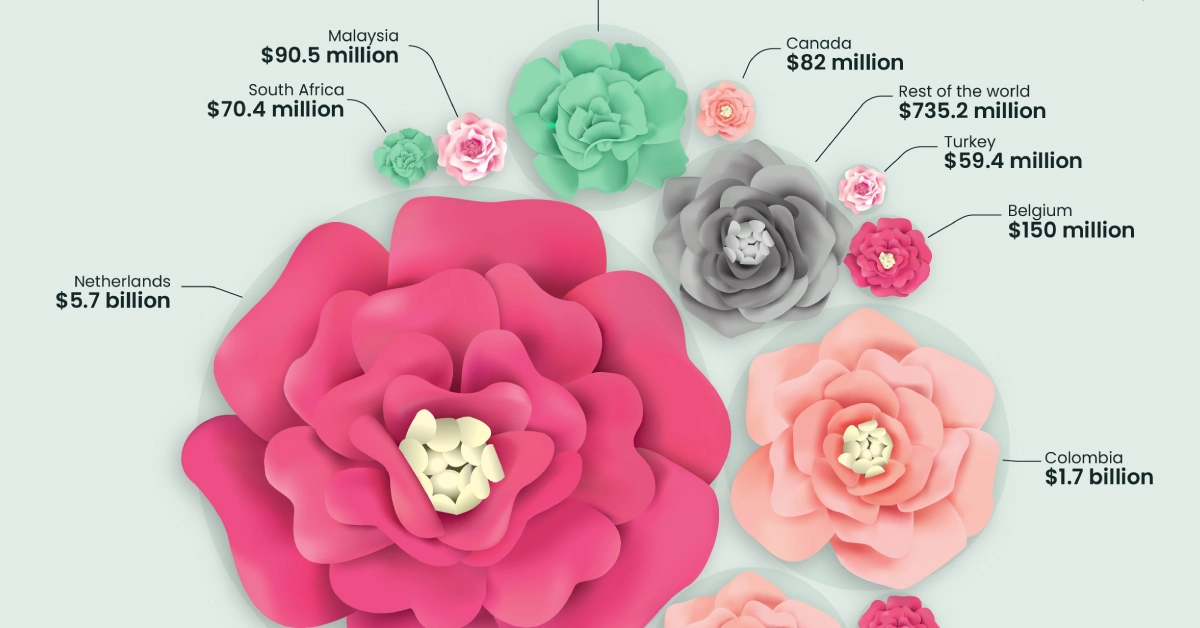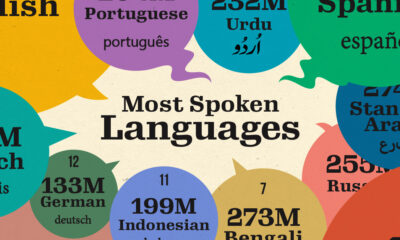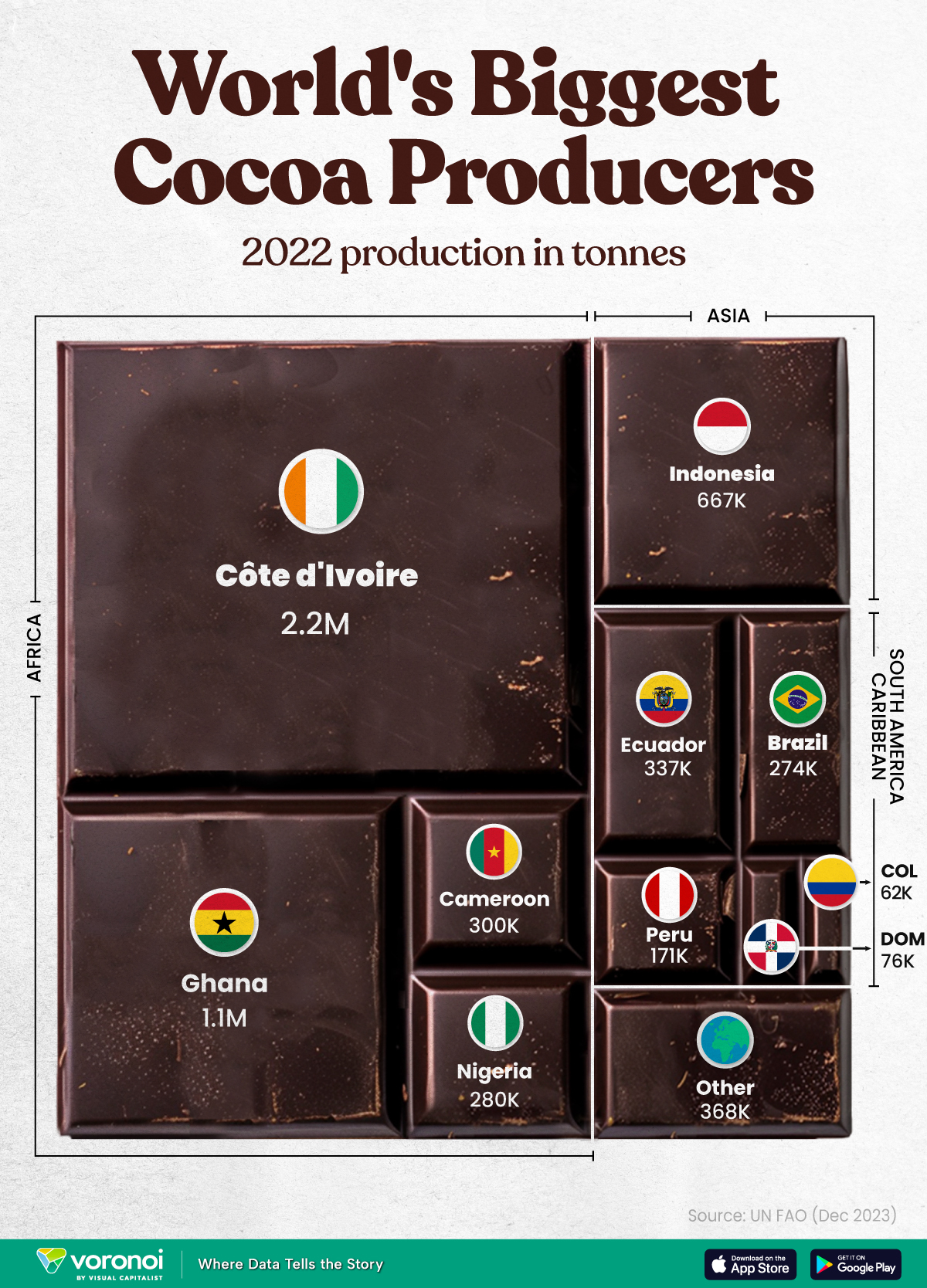Agriculture
Visualizing the World’s Flower Bouquet Export Market
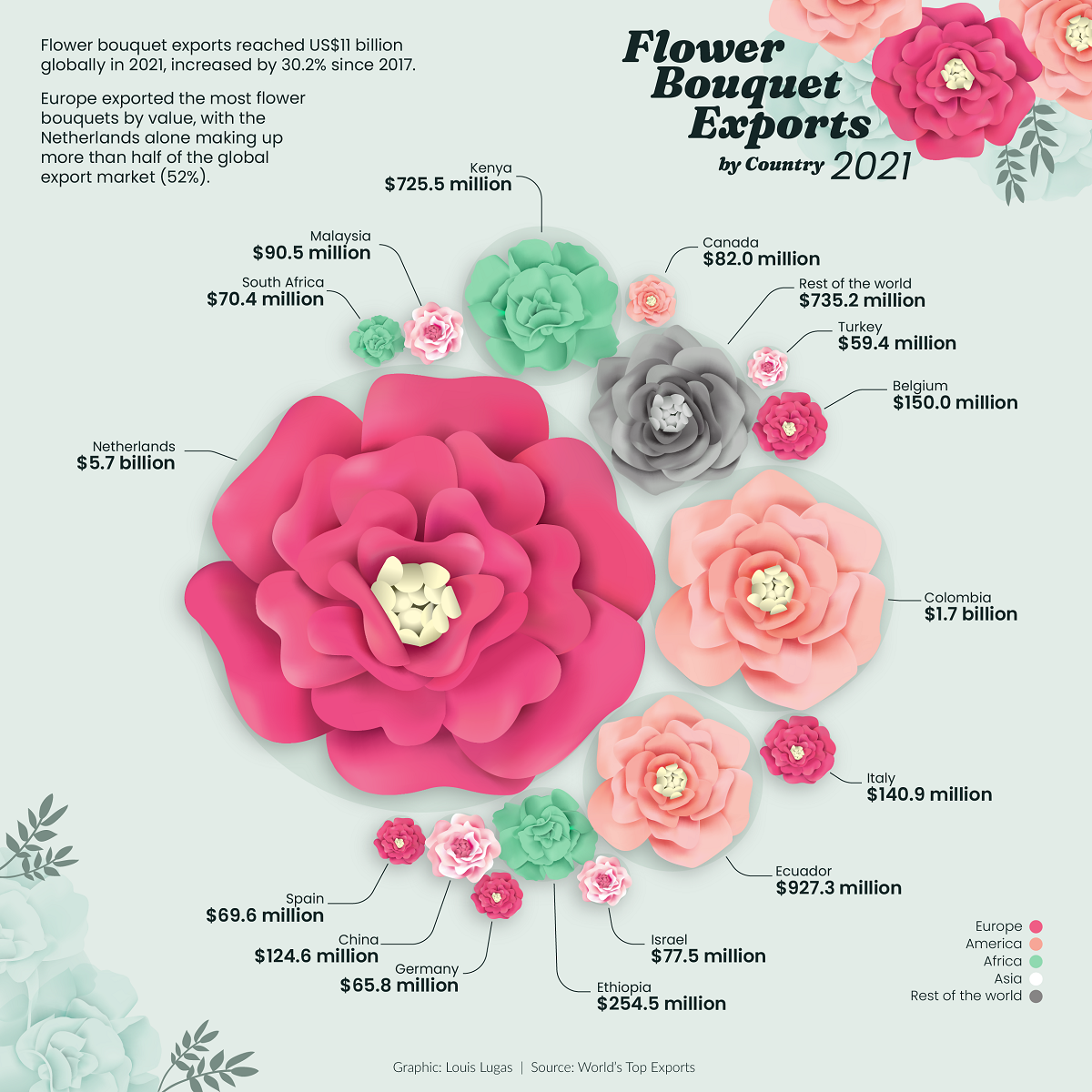
Visualizing the World’s Flower Bouquet Export Market
For many, flower bouquets are the go-to gift choice when congratulating a colleague, visiting an ailing relative, or simply showing love and kindness to partners and friends.
And the global popularity of these carefully-arranged and vividly-colored bundles has led to the creation of a billion-dollar flower bouquet market. And demand for beautiful bouquets has kept growing, with global flower bouquet exports in 2021 reaching $11 billion—which is a 30.2% rise since 2017.
Louis Lugas Wicaksono uses data from World’s Top Exports to highlight the spread of this industry. In this image, he shows the flower bouquet exports across different countries in 2021.
Countries Trading the Most Flower Bouquets
Far at the top of the list and best known for their tulips, the Netherlands dominated the flower bouquet export industry in 2021.
| Rank | Country | Continent | Flower Bouquet Exports (2021 USD) |
|---|---|---|---|
| 1 | 🇳🇱 Netherlands | Europe | $5.7B |
| 2 | 🇨🇴 Colombia | America | $1.7B |
| 3 | 🇪🇨 Ecuador | America | $927.3M |
| 4 | 🇰🇪 Kenya | Africa | $725.5M |
| 5 | 🇪🇹 Ethiopia | Africa | $254.5M |
| 6 | 🇧🇪 Belgium | Europe | $150.0M |
| 7 | 🇮🇹 Italy | Europe | $140.9M |
| 8 | 🇨🇳 China | Asia | $124.6M |
| 9 | 🇲🇾 Malaysia | Asia | $90.5M |
| 10 | 🇨🇦 Canada | America | $82.0M |
| 11 | 🇮🇱 Israel | Asia | $77.5M |
| 12 | 🇿🇦 South Africa | Africa | $70.4M |
| 13 | 🇪🇸 Spain | Europe | $69.6M |
| 14 | 🇩🇪 Germany | Europe | $65.8M |
| 15 | 🇹🇷 Turkey | Asia | $59.4M |
| 🌎 Rest of the world | $735.2M |
The small European nation exported $5.7 billion worth of bouquets in 2021, accounting for over half of global flower bouquet trade. This dominance comes from centuries of being the world’s largest producer of flowers and being a floral trade hub due to its advantageous location and connections with other growers, suppliers, and wholesalers.
Colombia and Ecuador fall next on this list with their exports totaling $1.7 billion and $927 million, respectively. Roses, carnations, and chrysanthemums are heavily exported from these South American nations.
On the other side of the Atlantic, cut rose flower exports were the leading drivers for Kenya and Ethiopia, earning these African nations $725 million and $254 million respectively.
Together, these five nations contributed to 85% of the world’s flower bouquet trade in 2021.
Post-Pandemic Strategies
Despite the challenges posed by the COVID-19 pandemic, the flower bouquet export industry remained resilient. However, this was not an easy feat.
Many florists embraced new strategies like online sales and free home deliveries, and exporters dealt with global shipping slowdowns. Some countries including Columbia and Kenya focused on producing flowers with longer shelf lives that could be shipped further away.
As we continue to drift away from the pandemic and global trade eases up, we can expect this industry to blossom further.

This article was published as a part of Visual Capitalist's Creator Program, which features data-driven visuals from some of our favorite Creators around the world.
Markets
The World’s Top Cocoa Producing Countries
Here are the largest cocoa producing countries globally—from Côte d’Ivoire to Brazil—as cocoa prices hit record highs.
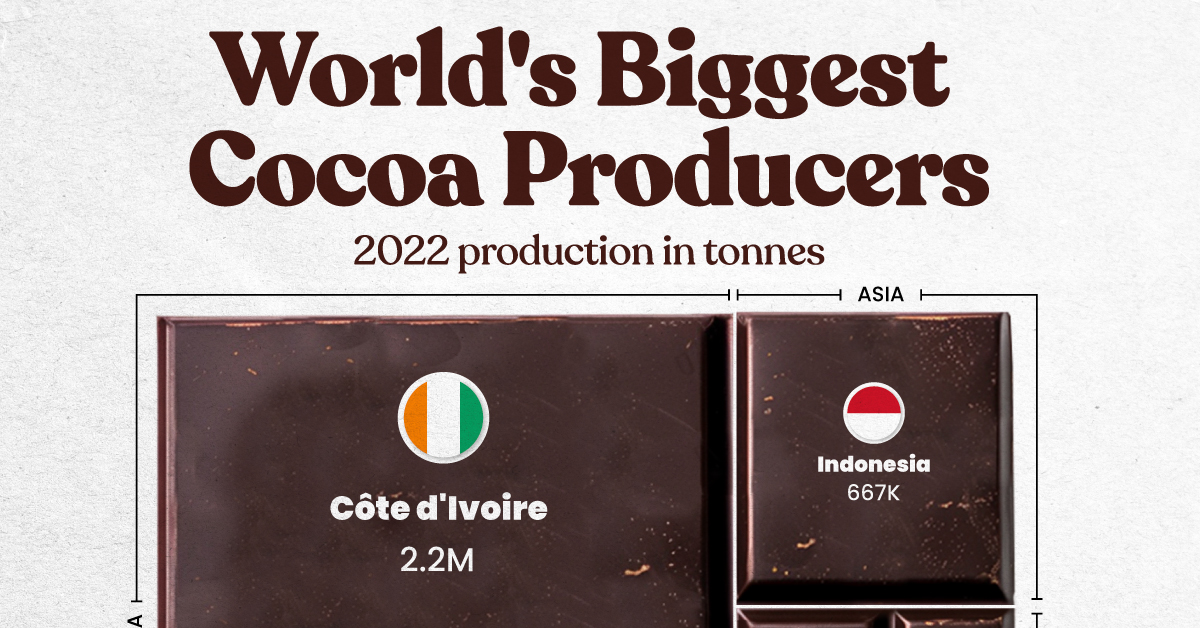
The World’s Top Cocoa Producing Countries
This was originally posted on our Voronoi app. Download the app for free on iOS or Android and discover incredible data-driven charts from a variety of trusted sources.
West Africa is home to the largest cocoa producing countries worldwide, with 3.9 million tonnes of production in 2022.
In fact, there are about one million farmers in Côte d’Ivoire supplying cocoa to key customers such as Nestlé, Mars, and Hershey. But the massive influence of this industry has led to significant forest loss to plant cocoa trees.
This graphic shows the leading producers of cocoa, based on data from the UN FAO.
Global Hotspots for Cocoa Production
Below, we break down the top cocoa producing countries as of 2022:
| Country | 2022 Production, Tonnes |
|---|---|
| 🇨🇮 Côte d'Ivoire | 2.2M |
| 🇬🇭 Ghana | 1.1M |
| 🇮🇩 Indonesia | 667K |
| 🇪🇨 Ecuador | 337K |
| 🇨🇲 Cameroon | 300K |
| 🇳🇬 Nigeria | 280K |
| 🇧🇷 Brazil | 274K |
| 🇵🇪 Peru | 171K |
| 🇩🇴 Dominican Republic | 76K |
| 🌍 Other | 386K |
With 2.2 million tonnes of cocoa in 2022, Côte d’Ivoire is the world’s largest producer, accounting for a third of the global total.
For many reasons, the cocoa trade in Côte d’Ivoire and Western Africa has been controversial. Often, farmers make about 5% of the retail price of a chocolate bar, and earn $1.20 each day. Adding to this, roughly a third of cocoa farms operate on forests that are meant to be protected.
As the third largest producer, Indonesia produced 667,000 tonnes of cocoa with the U.S., Malaysia, and Singapore as major importers. Overall, small-scale farmers produce 95% of cocoa in the country, but face several challenges such as low pay and unwanted impacts from climate change. Alongside aging trees in the country, these setbacks have led productivity to decline.
In South America, major producers include Ecuador and Brazil. In the early 1900s, Ecuador was the world’s largest cocoa producing country, however shifts in the global marketplace and crop disease led its position to fall. Today, the country is most known for its high-grade single-origin chocolate, with farms seen across the Amazon rainforest.
Altogether, global cocoa production reached 6.5 million tonnes, supported by strong demand. On average, the market has grown 3% annually over the last several decades.
-

 Mining2 weeks ago
Mining2 weeks agoCharted: The Value Gap Between the Gold Price and Gold Miners
-

 Real Estate1 week ago
Real Estate1 week agoRanked: The Most Valuable Housing Markets in America
-

 Business1 week ago
Business1 week agoCharted: Big Four Market Share by S&P 500 Audits
-

 AI1 week ago
AI1 week agoThe Stock Performance of U.S. Chipmakers So Far in 2024
-

 Misc1 week ago
Misc1 week agoAlmost Every EV Stock is Down After Q1 2024
-

 Money2 weeks ago
Money2 weeks agoWhere Does One U.S. Tax Dollar Go?
-

 Green2 weeks ago
Green2 weeks agoRanked: Top Countries by Total Forest Loss Since 2001
-

 Real Estate2 weeks ago
Real Estate2 weeks agoVisualizing America’s Shortage of Affordable Homes

